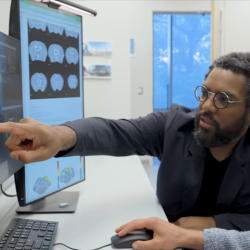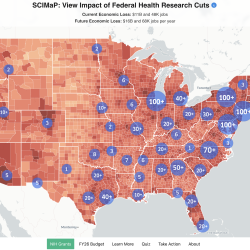Data Analysis Tools Advance Medical Knowledge
Ben Shneiderman, professor of computer science and founding director of the university’s Human Computer Interaction Laboratory, and his colleagues have long been recognized for their work in the field of visualization — exploring different ways to visually display information on the computer screen. Their pioneering research more than 20 years ago resulted in the creation of the commercially developed hyperlink interface that gave users the capacity to click for more information and that Tim Berners Lee, founder of the World Wide Web, credits with shaping his thinking.
More recently, Shneiderman’s work has focused on developing software that enables physicians to easily access and analyze large volumes of data. “In the late 1990s, we developed Lifelines to look at single-patient histories,” explains Shneiderman, who has collaborated closely with Research Scientist Catherine Plaisant in the University of Maryland Institute for Advanced Computer Studies (UMIACS), for more than two decades. “We could show 10,000 medical events — sonograms or x-rays or prescribed medications — over a 100-year history for a single patient.”
Working with colleagues in UMIACS, they have designed a new computer interface that takes the concept to the next level. Lifelines2 allows doctors to access groups of patient histories to analyze emerging health patterns. “Lifelines2 provides the ability to align, rank, and filter the results of physician queries,” explains Shneiderman. For instance, a physician may be studying the causes of initial heart attacks in patients. By reviewing records before and after a similar heart event for up to 10,000 patients, the physician can begin to see patterns on the computer screen, such as a common event that may have triggered the heart attacks.
Lifelines2 has been implemented as part of Harvard Medical School’s i2b2 (Informatics for Integrating Biology and the Bedside), an initiative funded by the National Institutes of Health (NIH). Most recently, the NIH has integrated Lifelines2 into its Biomedical Translational Research Information System (BTRIS) for clinical research data. “We believe that Lifelines2 will better enable researchers to use their visual, pattern-matching skills to detect correlations across populations of research subjects,” says James J. Cimino, M.D., chief of the Laboratory for Informatics Development at the NIH Clinical Center and National Library of Medicine. “Helping researchers find better ways to analyze their data should help patients everywhere through improved research results.”
“The NIH database encompasses a 30-year history of clinical trials that is often underutilized,” describes Shneiderman. “We’ve provided a tool to make it easier for physicians to analyze the data, and, in a way, enable a simulated clinical trial. You can find 40,000 people with a similar medical history then follow their treatment histories to track best possible outcomes.”
“We work to design real solutions for real people,” explains Shneiderman. “Seeing our prototypes refined and integrated in real systems is very rewarding.”
He adds, “My punchline always is that the goal of visualization is insight, not pictures. When we work with people who have been wrestling with data for months and years and did not see patterns we show them in minutes, that’s exciting.”
The next step for Shneiderman and his colleagues: LifeFlow, a program that can potentially summarize medical records of up to 10 million patients on a single screen.







